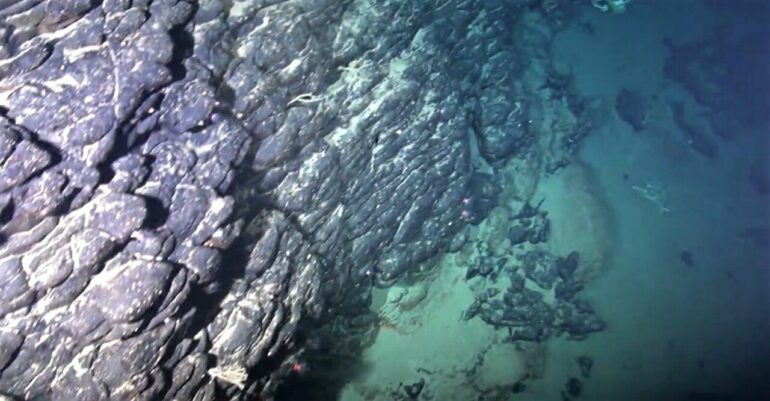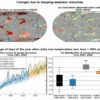A study led by scientists at the University of São Paulo (USP) in Brazil has shown that the Rio Grande Rise (RGR), a possibly continental basaltic plateau and chain of seamounts now submerged in the South Atlantic Ocean some 1,200 km from the coast of Brazil, was once a giant tropical island, rich in minerals and covered with vegetation. Geologists have dated sediments from the formation to between 45 million and 40 million years ago.
The study, which involved almost 10 years of research, is published in the journal Scientific Reports with new information on the geology of the RGR, which has about the same area as Spain.
The researchers analyzed samples of sea floor sediment dredged at a depth of about 650 m in the western RGR and characterized its mineralogical, geochemical and magnetic properties. The samples contained mainly red clay with several minerals typical of tropical volcanic rock alterations, such as kaolinite, magnetite, oxidized magnetite, hematite and goethite.
In 2018, the group posited that the RGR was once an island, based on discoveries made by scientific expeditions to the region, where they collected a sample. They traveled on the Royal Research Ship (RRS) Discovery, operated by the United Kingdom’s National Oceanography Center (NOC), and the Alpha Crucis, USP’s oceanographic research vessel. The researchers were from USP’s Oceanographic Institute (IO) and the University of Southampton in the UK.
“Our research and analysis enabled us to determine that it was indeed an island, and what’s now under discussion is whether the area can be included in Brazil’s legally recognized continental shelf. Geologically speaking, we discovered that the clay was formed after the last volcanic activity occurred 45 million years ago. The formation therefore dates from between 30 million and 40 million years ago. And it must have been formed as a result of these tropical conditions,” Luigi Jovane, last author of the article and a professor at IO-USP, told Agência FAPESP.
For Jovane, the fact that a multidisciplinary team participated in the research contributed to the results. “We have a group of the highest quality including specialists in geology, geochemistry, biology, hydrodynamics, environmental impact assessment, new energies, psychology, and law. All this accumulated science can be used to deepen our understanding of the RGR and prospect the region without affecting the local system’s synergies,” Jovane said.
“To know whether resources can be viably extracted from the sea floor, we need to analyze the sustainability and impacts of this extraction. The ecosystem services provided by the ocean there haven’t been studied in detail, for example. When you interfere with an area, you have to know how this will affect animals, fungi and corals, and understand the impact you’ll have on the cumulative processes involved.”
In 2023 alone, Jovane led the production of four other articles with results of studies involving volcanic rock and ferromanganese crust samples from the RGR. The articles are published in Frontiers in Marine Science, Journal of Materials Research and Technology, Geochemistry and Marine Geology.
Sea floor discoveries
The scientists focused on the western portion of the RGR, which they reconstructed by high-resolution bathymetric mapping that showed plateaus covered with sediment and separated by a rift with a depth of more than 600 m. They used an autonomous underwater vehicle (AUV) and a remotely operated vehicle (ROV) from the Discovery to produce maps, videos and sonar surveys.
The AUV is capable of diving down to the sea floor and covering a pre-established area for a maximum of 12 hours. The ROV is connected to the ship by a cable as it moves while producing high-resolution images, and collecting samples of rocks and organisms with a robotic arm.
“No one in Brazil has AUVs or ROVs, so partnering with our British colleagues at the NOC was fundamental, but the research is 100% Brazilian,” Jovane said.
The existence of tropical soil between the volcanic lava flows detected by the researchers shows that the rocks must have been exposed to open-air weathering in a warm-wet climate in a region with active volcanoes less than 40 million years ago. The soil is similar to the “red earth” (terra roxa) found in many parts of São Paulo state, according to Jovane.
The most widely used measure of rock weathering, known as the chemical index of alteration (CIA), was 93 for the red clay. Most alkaline rocks have a CIA of less than 50. This high value points to its origin in extreme weathering of lava flows and volcanic rocks during the Eocene (the second epoch of the Paleogene Period) between 56 million and 34 million years ago, when high temperatures favored the development of tropical forests, before the sudden climate changes that occurred when Australia split off rapidly from Antarctica. The open-air erosion was followed by thermal subsidence and submergence during the late Eocene and early Oligocene between 35 million and 25 million years ago.
The RGR has been intensely studied in recent years because of its economic potential. It is in international waters and hence governed by the International Seabed Authority (ISA). In December 2018, the Brazilian government applied for an extension of its continental shelf to include the RGR, which is well beyond the limit of 200 nautical miles established for all nations by the UN Convention on the Law of the Sea (UNCLOS).
Areas rich in cobalt, nickel and lithium, as well as tellurium and other rare earths critical to the transition from fossil fuels to renewable energy, one of the main drivers of global warming, have been detected in the RGR.
“It’s important to understand the ecosystem services and other natural processes at work in the RGR,” Jovane said. “Only this knowledge can enable us to carry out the environmental impact assessments and calculate the mitigation measures and offsets required to protect it if economic development is permitted.”
More information:
Priyeshu Srivastava et al, Red clays indicate sub-aerial exposure of the Rio Grande Rise during the Eocene volcanic episode, Scientific Reports (2023). DOI: 10.1038/s41598-023-46273-y
Citation:
Study shows that Rio Grande Rise was once a giant mineral-rich tropical island near Brazil (2024, February 1)



